Cleaning your bathroom isn't the most glamorous of tasks but it's something we all need to do at some point! That's why we've created this handy guide to help you learn the best way to clean your bathroom and give you some tips to help it stay clean in the future.
If you are using any cleaning products we'd always recommend wearing gloves and some eye protection. It's also important to ensure the room is well ventilated so open a window and switch your extractor fan on.
Getting Your Bathroom Ready For Cleaning
1. Declutter
Before you start to clean your bathroom it's important to remove any of the clutter which could get in your way. This includes:
- Shampoo & shower gel bottles from the shower.
- Any bath mats on the floor and towels on the towel rail.
- Any items which sit on your bathroom countertop.
This will give you a clear space to work and you won't need to worry about splashing anything with cleaning products.
2. Dust and Sweep
Next up, you'll need to dust the bathroom surfaces to remove any loose dirt which might be sitting on top. Once you've done this you can vacuum or sweep the floor to remove any loose dirt there. It's important to dust the surfaces first, as you don't want to brush any dirt onto a floor you've already cleaned.
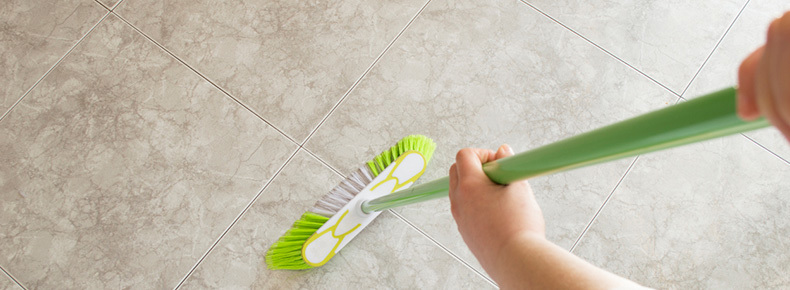
3. Apply Cleaner To Tougher Areas
Before you start to really scrub any dirt and grime, it's a good idea to leave some bathroom cleaner to soak on the areas which will need the most care.
First apply cleaner to your bathtub, shower and areas with limescale build up. Your choice of cleaner is largely down to personal preference. For cleaning limescale we'd recommend using a solution of half white vinegar, half water.
You should also pour some bleach down your toilet and leave this to work.
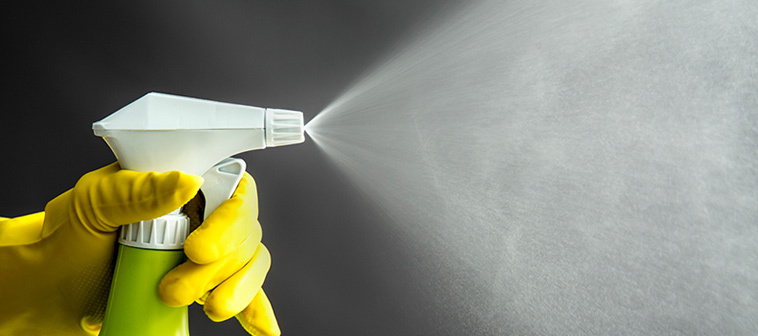
Cleaning The Bathroom
1. Wipe Down Surfaces
Now you've removed all the items on your counter tops and taken care of any dust, it's time to start wiping down the surfaces. Here you'll need to take a cloth and clean the counter tops, shelves and cupboard doors with your cleaning spray.
When cleaning surfaces we'd always recommend starting at the highest point in your bathroom then working your way down. This way if any grime you've cleaned from higher shelves makes its way down to lower surfaces, you can clean them later on.
You'll need to use a different cleaner for your bathroom windows and shower glass panels. Although specific cleaners are available, once again a vinegar spray can be really effective. If you need anymore help, take a look at our guide to cleaning shower glass.
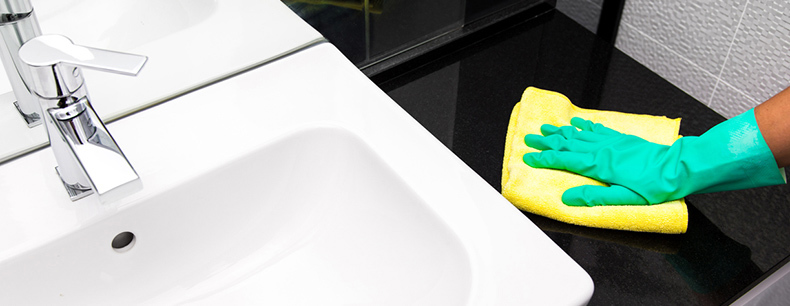
2. How To Clean The Shower and Bathtub
Now it's time to clean your shower and/ or bathtub. If you've allowed your cleaner to soak in, you should be able to remove the majority of grime with ease. Use a soft cloth or sponge to do this and work from the top of the bathtub downwards. If you've got lots of limescale on either your taps or the bathtub itself, this will require some extra care. Jump to number 3 to learn how you can do this.
If a lot of grime has accumulated in the grout between your bathroom tiles, you may need some more focused cleaning. For this use a purpose made shower and grout cleaner and an old toothbrush or other soft bristled brush. Spray the cleaner onto the grout and leave it for up to ten minutes to soak in. You can then use your soft brush to scrub the grout and remove the grime. Remember to start at the top of the tiled section and work your way down.
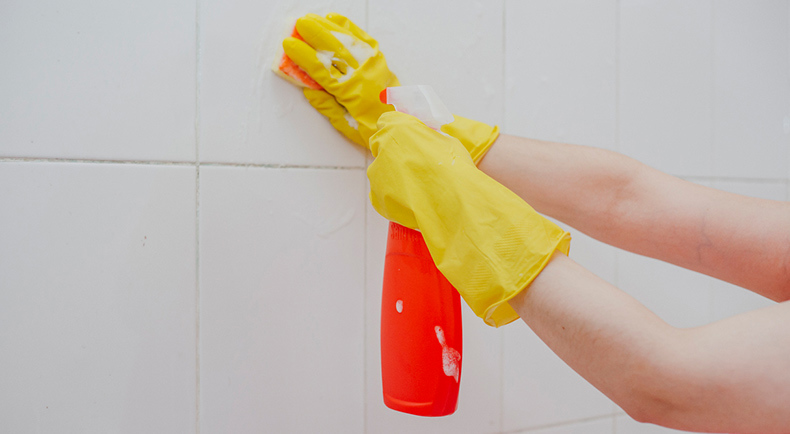
3. Removing Limescale
The areas of your bathroom with limescale build up will need some extra attention. When attempting to clean limescale we'd always recommend wearing gloves and checking whether any cleaning products are suitable. Although specific cleaners to remove limescale are available, often natural solutions can be just as, if not more, effective.
To create your own limescale cleaner, mix up a spray bottle with half white vinegar, half water. You can also use half lemon juice, half water too. Spray this solution liberally on areas with limescale and leave it to soak for at least half an hour, or up to 2 hours for particularly bad stains. Once you've let it work you can then scrub it with a sponge and the limescale should lift away.
If you want to remove limescale from a shower head or tap spout, you'll need to use a slightly different method. Dom Lees-Bell, bathroom expert at Drench says that, "removing limescale from your showers and taps isn't as hard as it looks! Simply fill a plastic sandwich bag with white vinegar, place over your shower head or tap spout and secure with an elastic band. All you have to do is leave it to work overnight and give it a rinse with water in the morning."
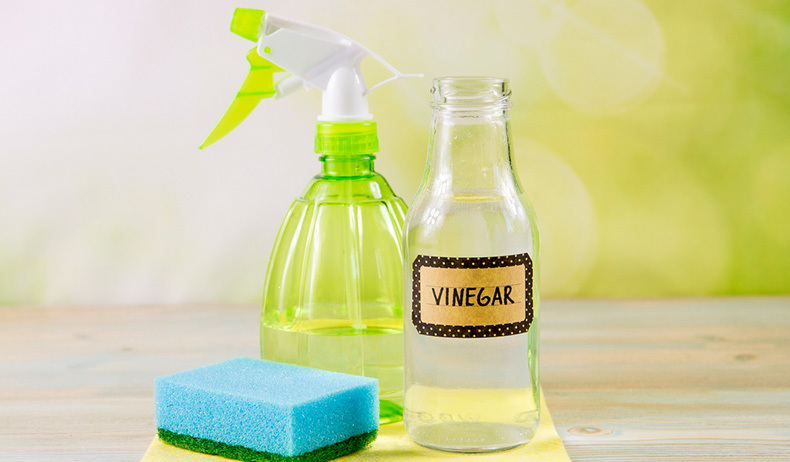
4. How To Clean a Toilet
Next up it's the most dreaded job: cleaning the toilet! When cleaning your toilet we'd recommend having a second pair of gloves and sponges just for the toilet. It's a good idea to have them in a different colour so you can remember.
You'll want to tackle the toilet bowl first. Take some bleach and pour it around the entire bowl, then leave it to soak for a few minutes. After this, take a toilet brush and start scrubbing the entire bowl including the rim (unless you're lucky enough to own a rimless toilet).
If there's lots of limescale in your toilet bowl, you can use white vinegar again. Pour the vinegar around the entire bowl and leave it to soak for 3-4 hours. Once it's had time to soak you can start scrubbing and the limescale should start to disappear. If this doesn't do the trick you can add more vinegar or even leave the vinegar to sit overnight. Once you're finished, simply flush the toilet and you should have a sparkly clean bowl.
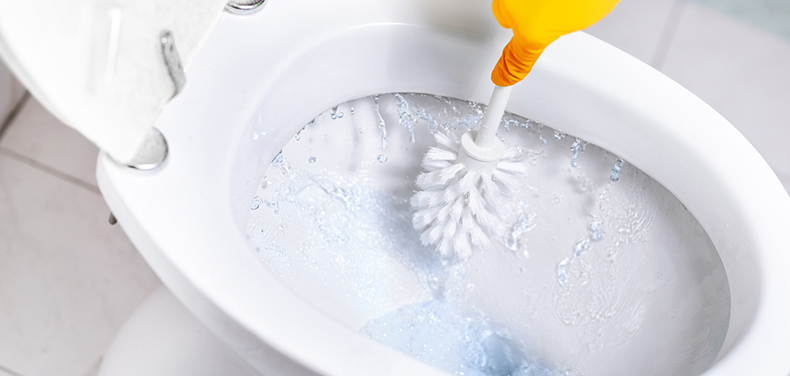
5. Mop The Floor
Once you've cleaned everything else the last job is to mop the floor. Before mopping, it's a good idea to vacuum or sweep the floor to remove any excess dirt.
There will be lots of different cleaner types on offer and you can often find one to suit your specific floor type. Mix the detergent and hot water in one bucket and then fill up a separate bucket with just hot water.
Dip the mop into the bucket then wring it out. Remember if the mop is too wet it won't clean any better but the floor will take twice as long to dry out. Start mopping the floor at the furthest point from the door then work back towards it. Use the second bucket to rinse the mop. This is something people will often forget to do but it ensures you aren't simply adding dirty water back into the bucket with cleaning solution.
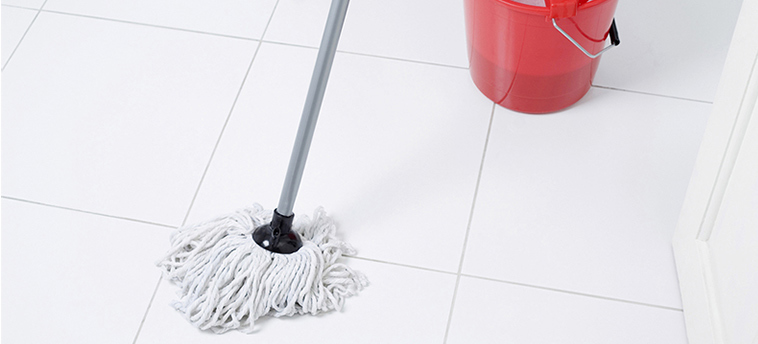
How To Keep Your Bathroom Clean
Now you've got your bathroom nice and clean you'll want to try and keep it that way. Take a look at our top tips for keeping your bathroom in pristine condition.
Little & Often
The best way to keep your bathroom clean and avoid harder work further down the line is to clean regularly. Whether its wiping the surfaces more often, mopping the floor weekly or a monthly clean of the shower glass, a small amount of work will keep your bathroom products looking great and avoid the hassle of more drastic cleaning later on.
Use An Extractor Fan
Many of the cleaning problems associated with bathrooms are caused by the damp environments showers & baths create. Purchasing a bathroom extractor fan and using it regularly will help prevent moisture build up which will create mould or mildew.
Clean Toothpaste Straight Away
One of the most common sights in basins is the toothpaste stain. These will usually develop when toothpaste which has fallen into the basin is left to dry out. That's why it's important to clean toothpaste from your bathroom sink straight away. Although this may seem time consuming, it's a lot easier than trying to clean it later on when it's completely dried out.
Shower Cubby Hole
As seen in our Bathroom Storage Ideas article, shower cubby holes are a stylish way to keep your bathroom clutter free. Relatively simple to create, these are the perfect minimalist solution for keeping your shower tidy and can be enhanced with modern LED lighting.

Shower Squeegee
Getting your shower glass back to its best can be a time consuming and frustrating process. That's why investing in a shower squeegee to quickly remove any excess water from the glass every time you shower is a no brainer!







